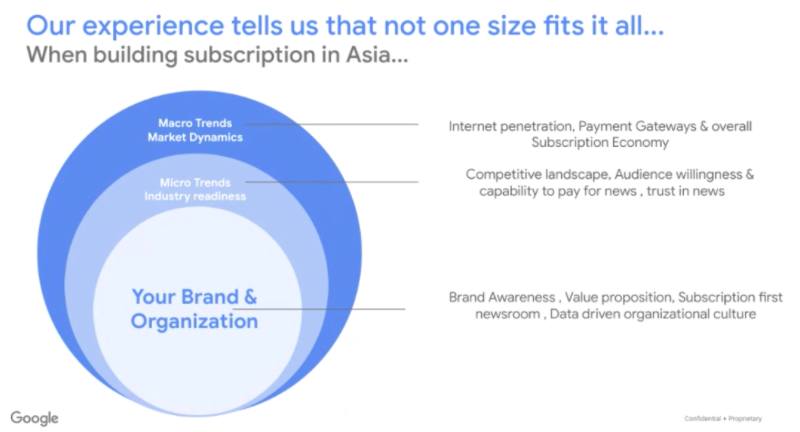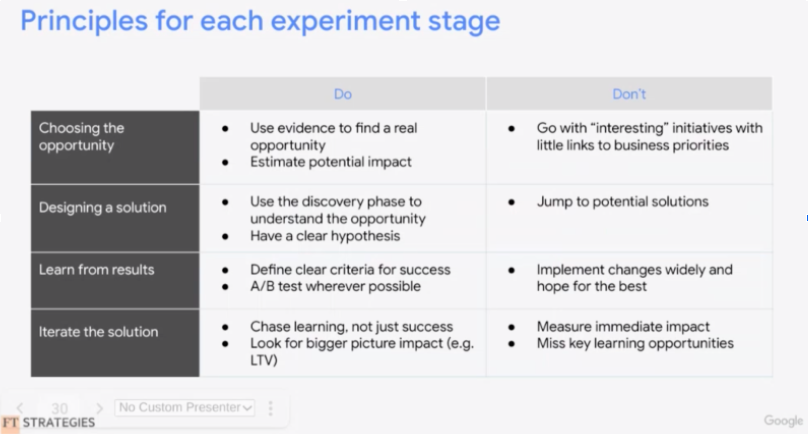Above: At the 2021 Asian Media Leaders eSummit, Rohan Tiwary (top left), Head of Media, News & Entertainment Partnerships at Google Asia Pacific, Sheena Bhalla (top right), Data and Innovation Lead for GNI-APAC, and Uma Patel (bottom), Senior Consultant (Business Strategy) at FT Strategies. The three shared insights and results from GNI Subscriptions Labs’ participants’ ongoing efforts towards sustainable reader revenue growth.
By Debbie Goh
In 2020, India’s The Hindu and Cambodia’s Southeast Asia Globe conducted an experiment, where they introduced a pop-up on their websites that showed their newsletter offerings to new users. The simple tweak led to 52,000 new subscribers for The Hindu and 16,000 for the Globe.
The experiments were conducted during Google News Initiative Subscriptions Lab’s pilot programme with eight Asia-Pacific news publishers – The Hindu, Globe, BloombergQuint, Jakarta Post, Kompas.id, Business Insider Japan, Malaysiakini, and CommonWealth Magazine.
During the four-month programme that began last October, these publishers worked with Google and FTI Consulting to strengthen their digital subscriptions capabilities and grow reader revenue.
At the Asian Media Leaders eSummit 2021, GNI Subscription Labs shared insights on the trends shaping Asia-Pacific news subscriptions and the results from the experiments conducted by its participating publishers to reach their subscription goals.
A key takeaway from the project was that “there is not one clear path to subscription success,” according to Data and Innovation Lead for GNI-APAC Sheena Bhalla.
“When you start thinking of the different dynamics working within your market and within your region, you have to consider a lot of moving trends in order to launch a successful subscription business,” she said.

Bhalla added that publishers must evaluate macro and micro trends in their markets and regions, as well as their own brand and organisation. She said that those trends, which include internet penetration, availability of payment gateways, audience capability and willingness to pay for news, and reader awareness of publishers’ brand and value propositions, will influence strategies for growing reader revenue.
For example, digital savviness was typically directly correlated with digital circulation but in Japan, digital savviness was very high while circulation was really low.
“A business trying to launch subscriptions in Japan has to tackle different trends,” said Bhalla. Similarly, though GDP is often a good signal for users’ willingness to pay for subscriptions, Google’s user research indicated readers in less digitally savvy markets like India and Indonesia were more willing to pay for subscriptions although capacity to pay was lower.
“It is really important to look at the smaller experiments and build subscription confidence before you take up fully,” Bhalla said.
She presented four areas the participating publishers experimented in: enabling data for audience segmentation, building a value proposition that resonates, driving higher reader engagement, and optimising the user funnel.
Enabling data foundations to expand segmented approach
Audience segmentation data, said Bhalla, was a key strategy for publishers to personalise offerings to their subscribers. However, “most partners were not tracking user data correctly either within their analytics platform or within their paywall,” said Bhalla.
“Audience segmentation is only possible if you’re sending the right kind of reader actions and reader definitions within your code.”
Reader actions, for example, can be differentiated in terms of product subscription, login data, newsletter subscription, paywall impressions and paywall clicks. Reader definitions can be differentiated in terms of reader ID, subscription status, subscription product, the kind of product they were logged in to, number of articles read, and number of remaining free articles.
“This kind of audience segmentation data is really important because it is a key tactic to developing personalised offerings for your subscription base and by offering tailored user experience, you are more likely to continue to improve on loyalty,” she said.
During the subscriptions lab, Bhalla worked with publishers to identify content preferences associated with engaged, semi-engaged and non-engaged readers.
These experiments helped partners understand how different types of users were engaging on their property and Increased their capabilities to measure and compare subscriber and non-subscriber behaviours.
Building a value proposition that resonates
A well-crafted value proposition can decide whether a reader converts into a subscriber or not, said Bhalla. BloombergQuint in India experimented with building a clear and concise message to communicate its value across various subscription and marketing assets.
Results from the four-month project showed that when BloombergQuint made its value proposition clearer on its website, digital subscription revenue increased 2% quarter-on-quarter, signups increased 50 percent, and there was more adoption of the 12-month plan, said Bhalla.
Driving reader engagement
Newsletters are key to acquiring users, building an e-mail user database for targeted marketing campaigns, and retaining subscribers. The Hindu’s and the Globe’s experiments showed that small tweaks could lead to big returns in increasing reader engagement.
This simple strategy enabled the two publishers to increase their email newsletter database and build a more robust subscription model, said Bhalla.
Optimising the user funnel
Churn, which is defined as the rate at which users end their subscriptions, is very high in Asia Pacific, said Bhalla. She added that the global benchmark averages 3% to 5% but in the Asia-Pacific, the churn averages 6.5%, and as high as 15% across participating publishers.
After identifying non-recurring payment methods as a common reason for churn, Indonesia’s Kompass.id, which is in a market without high credit card payment, experimented with using pricing to incentivise longer subscription terms. By increasing its term plan, it saw almost 45% of new subscribers on long-term plans, said Bhalla.
Many experiments can be done but they must align with business objectives, said Uma Patel, senior consultant at FT Strategies, which collaborated on the European GNI Subscriptions Lab.
She presented a four-stage approach to designing experiments, namely:
- Set long-term goals on what publishers want to achieve in 3 to 5 years.
- State objectives that define success.
- State what needs to be done to achieve the objectives.
- Set up the experiment to test the hypothesis.

Patel advised publishers to use evidence to find out what actually could be done, as well as “really talking to people and figuring out what is the opportunity, what do your customers want, what readers really want from you, and how to develop a solution according to that.”
“You’re not going to get it completely right or completely wrong the first time. Every single experiment can be learnt on and iterated upon to bring in more people to that subscription base,” said Patel.
The report on GNI-APAC Subscriptions Lab is available on the Digital Growth Program is available at:
https://newsinitiative.withgoogle.com/digital-growth/na-gni-labs/
About the author: Debbie Goh, Ph.D., is an assistant professor in the Department of Culture, Media, & Performance at the California University of Pennsylvania.
Edited by Arulnathan John: Arulnathan John has had a journalism career spanning more than 20 years, and has covered a variety of news genres for media agencies in Singapore.

